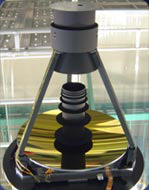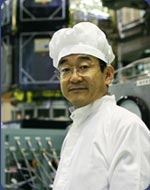|
 |
 |
 |
 |
 |
 |

Another notable technological advance, and a world first, is making the telescope mirror out of a new material, a type of ceramic called carborundum. As a result, the 70 cm mirror weighs only 11 kg. If made of glass, it would weigh as much as 200 kg. We were delighted to be able to make such a light and smooth mirror. But we also used a new material for the truss supporting the mirror, and this caused a problem. In the end, we had to delay the launch for a year and a half. Under the leadership of engineers from ISAS (the Institute of Space and Astronautical Science), involving experts in space technology from the former NASDA and from universities, a special team was formed and many experiments were conducted. At last, we all have confidence in the telescope. |
 |

Reflecting mirror made with the light new material carborundum |
 |
 |


NASA and the ESA are the only space agencies in the world to have succeeded in launching an infrared astronomical satellite. Japan, so far, has had success in launching balloons, sounding rockets, and the IRTS, which was mounted on a multifunctional experimental satellite. I think we are doing well in the field of infrared astronomy, and if Akari accomplishes its mission, Japan will be the third space power to obtain an infrared astronomical satellite, becoming one of the top three. In addition, Akari will finally update the All Sky Survey data, after 20 years.
|
 |

 |
 |
 |
Hiroshi Murakami
Lead Manager, Department of Infrared Astrophysics, ISAS/JAXA
After graduating from and working as an associate at the graduate school of Nagoya University, Prof. Murakami began his career at ISAS/JAXA in 1987. He specializes in infrared astronomical observation using balloons and sounding rockets. In 1995, Prof. Murakami participated in Japan's first, experimental Infrared Telescope in Space (IRTS), which was carried on the satellite SFU. He has been working on Akari (ASTRO-F) since the beginning of its planning stages, and became project manager in April 2005.
Prof. Murakami developed an interest in science early, and as a child would make monthly visits to the planetarium. In elementary school, he was inspired by the story of the late Dr. Hideo Itokawa, who built Japan's first rocket. Later, after some difficult soul-searching, he chose space over biology, and as his interest in galaxies grew, he decided to focus his graduate studies on infrared astronomy, even though this area had not yet been established in Japan. Prof. Murakami balances a theoretical approach with a love of making things and performing scientific experiments. His strong curiosity is reflected in his production of satellites and observation instruments. |
|
 |
 |
 |


|
|



